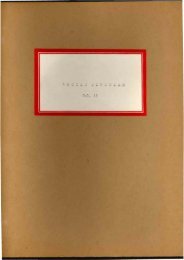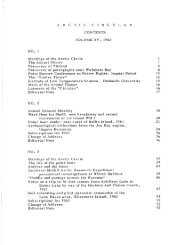Volume 4, 1951 - The Arctic Circle - Home
Volume 4, 1951 - The Arctic Circle - Home
Volume 4, 1951 - The Arctic Circle - Home
Create successful ePaper yourself
Turn your PDF publications into a flip-book with our unique Google optimized e-Paper software.
A comprehensive account of the fauna of the country<br />
between Norway House and York Factory, as well as of the<br />
Churchill district, was published by Edward Preble in 1902.<br />
Woodland caribou is reported to range throughout the region,<br />
while moose reach the Shamattawa River, which joins the<br />
Hayes about 50 miles above York Factory. Three polar bears<br />
were killed for dog food while the writer's party was at<br />
this post, and a prospector from Fox River stated that he<br />
had seen others swimming as far in1and as the lower<br />
Shamattawa. Indians are reported to have seen, in 1897,<br />
a pair of muskoxen on the barrens halfway between York<br />
Factory and Churchill. Preble believes this to be probably<br />
the most southern authentio reoord of the animal. Beaver,<br />
beooming scarce even at the time of Preble's survey, is<br />
.now rare1y taken, and muskrat fur is at present the prinoiple<br />
article of trade. Other anima1s trapped inc1ude otter,<br />
mink, wease1, marten, fisher, skunk, red fox, lynx, gray<br />
wolf, and wolverine. <strong>The</strong> Canada goose was once a staple<br />
article of food for posts along the Bay, and was salted<br />
down in large quantities for winter use. Apart from being<br />
'reduced in numbers by this means, there are indications<br />
that rapid uplift of the land along the southwestern side<br />
of the Bay has resulted in the drying up of large portions<br />
of the salt marsh feeding grounds of ducks and geese within<br />
memory of living man.<br />
During the 1950 season, the writer was accompanied<br />
by Mr. W.K.Vi. Baldwin, of the National Herbarium staff.<br />
<strong>The</strong> summer was spent largely in the prairie and forested<br />
regions of south and oentral Manitoba, but inoluded flights<br />
ta Baralzon and Nejanilini Lakes northwest of Churchill.<br />
Oamp on the eastern shore of Baralzon Lake was made on the<br />
81xtieth parallel, near the southern limit of that part of<br />
,the subarotio tundra which enters the northeastern corner<br />
of the province. Extensive areas of dry Barren Ground<br />
alternate with muskeg in wet depressions, while perhaps<br />
.one per cent of the terrain is oocupied by small patches<br />
of stunted blaok spruoe and tamaraok. <strong>The</strong> ground is oovered<br />
by a maze of tracks formed by the Barren Ground caribou<br />
durlng their seasonal migrations, the ruts in places being<br />
over a foot deep. Lemming burrows were numerous, but none<br />
.-S found to be occupied, although T.H. Manning reports that,<br />
,durlng 1949, the lemming cycle was at a high peak in many<br />
,plaoes in northern Canada. (<strong>Arctic</strong> Oircular, Vol. III,<br />
')ta, II (1950) p. 20). Many drowned lemmings were seen by<br />
the writer's party during the 1949 trip up the lower<br />
;~elson. No snowy owls were seen during the twelve-day<br />
.top at Baralzon Lake in early august, but many dried<br />
pellets containing the remains of lemmings were found<br />
below their rook perches. .












